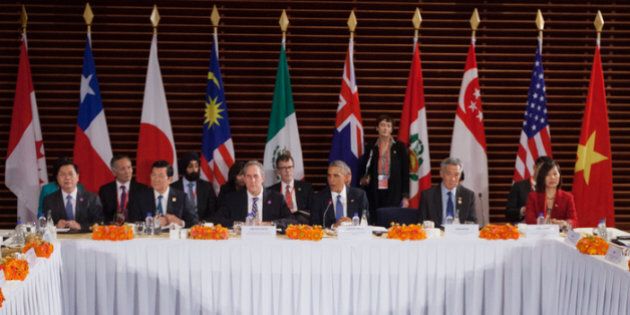
News that U.S. presidential candidate Hillary Clinton had joined the entire rest of the democratic field in opposing the Trans-Pacific Partnership may well sound the death knell for the agreement.
It also raises a few interesting possibilities about where things go next.
First though, on Clinton's "come to Jesus" moment: yes, it's politics (and primary politics to boot). And yes, we went through something similar with Obama and his promise to renegotiate NAFTA. But this is different.
The promise, or suggestion, or hint, to renegotiate NAFTA was as vague as the preceding string of nouns. There was never any hard, fixed event to force Obama's hand. He was free to keep procrastinating -- "second half of my term," "early next term for sure" -- until the public just kind of forgot. With the TPP on the other hand, once it's signed the clock starts ticking and the train starts rolling down the tracks. At some point early in her term, should she be elected, Clinton will have to take some action other than procrastination.
It's going to be hard, though not impossible, for Clinton to backtrack. Something like a suddenly menacing China could provide her cover with a "Well, as recent events demonstrate, things have changed..." but there is real and substantial opposition to the agreement on the left in her own party and the far right in the GOP.
Problems finding a house speaker and democratic primary challenges are small potatoes compared to a potential TPP fight. Also, bear in mind that the Donald has yet to really get going on the TPP. The damage that Ross Perot did to NAFTA will, as with so many things with the Donald, pale in comparison.
When faced with this sort of potential public beat down from so many zealots you generally have three options -- pray for divine intervention, ask for last rites, or run. Clinton will wisely choose the latter.
And so where does that leave the TPP?
With better access to the U.S. market off the table it's hard to see anyone still being interested in going ahead. Canada and Mexico, who already have better access to the U.S. market, have even less incentive to do anything.
For any sort of deal to work you need a coalition of the eager, those who really want a deal. Not a coalition of those signing up for fear of getting left behind.
One possible scenario is to link the Pacific Alliance to NAFTA if the U.S. can find some way to avoid having to negotiate a new treaty, perhaps if some authorization for executive authority to do so could be inferred in the NAFTA agreement. Likewise, the Pacific Alliance could look to do a deal with Australia-New Zealand or with ASEAN.
Or, given that Chile, New Zealand, Singapore and Brunei dar as-Salaam already have an agreement amongst them that could serve as the basis for adding a few of the TPP signatories into a smaller package. A new negotiating session here should not be difficult is it would mostly be a matter of dumping all of the things that the U.S. insisted be in the TPP, but which no one else really wanted -- good-bye State Owned Enterprises section.
Another scenario is China pushing ahead more quickly with its TPP, the Regional Comprehensive Economic Partnership also known as ASEAN +6 (China, Korea, Japan, Australia, New Zealand and India. The model here as with the Pacific Alliance, is to link countries that already have free trade agreements. While no one is thrilled with a Chinese dominated trade integration bloc, especially Japan, it beats the do-nothing Americans. If the RCEP gets going, adding the Pacific Alliance countries should not be difficult as most already have trade agreements with RCEP members.
The Americans wouldn't be happy with any of this; but really, what are they going to do? Especially if they're the ones responsible for scuttling the TPP. Also, the Pacific Alliance countries, Australia, Singapore and Korea already have trade agreements with the U.S. leaving less room for retaliation from D.C.
For countries outside of NAFTA, the TPP was less a big new market and more just getting NAFTA-like access to the U.S. That's what got everyone to make concessions. The calculation for Canada and Mexico was different; they really had no choice.
If the U.S. was going to give away their NAFTA benefits to everyone else, then the only choice was to go along and try to get the most out of it, say access to Japan. Canada was slow to the TPP table for a reason. But it's unlikely that Australia, New Zealand and others like Chile would now want to share Asian markets with Canada if they weren't getting better access to the U.S. market in return. Having been turned down once by Canada, the Pacific Alliance won't make an offer outside of a NAFTA-PA agreement.
So, that could leave Canada and the U.S. on the outside, with Canada back to square one, over-dependent on the U.S. and still trying to figure out how to get to the other side of the Pacific. It will only get harder as others move ahead.
MORE ON HUFFPOST:
